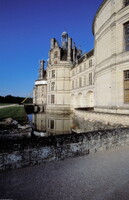| dc.coverage.spatial | Site: Château de Chambord (Chambord, Centre, France) | en_US |
| dc.coverage.temporal | 1518-1519 (design); completed after 1550 (creation) | en_US |
| dc.creator | Francis I, King of France | en_US |
| dc.creator | Domenico da Cortona | en_US |
| dc.creator | L'Orme, Philibert de | en_US |
| dc.creator | Leonardo da Vinci | en_US |
| dc.date | 1550 | en_US |
| dc.date.accessioned | 2013-02-22T14:57:38Z | |
| dc.date.available | 2013-02-22T14:57:38Z | |
| dc.date.issued | 1550 | en_US |
| dc.identifier | 193801 | en_US |
| dc.identifier.other | archrefid: 1414 | en_US |
| dc.identifier.uri | http://hdl.handle.net/1721.3/101135 | |
| dc.description | Lateral view of north elevation; French royal château near Blois, Loir-et-Cher. It was built by Francis I, who in 1516, a year after becoming king and fresh from his victories in northern Italy, asked Leonardo da Vinci to draw up the plans for a new château to be built at Romorantin. This project was abandoned two years later, and the King decided to build instead at Chambord, on the edge of a great forest that was enclosed to make a hunting park. Construction started in 1519 and speeded up after 1526; it continued throughout Francis I's reign and was brought to a close under Henry II towards 1550, when the château was almost completed. It was later repaired and finished in the original style under Louis XIV. The project is extraordinary both for its sheer scale (the façade is 156 m long) and, still more, for its originality. The four enormous, round corner towers and the fantastic outline of the building's upper parts, bristling with chimney stacks, dormer windows and turrets, evokes the great princely châteaux of the end of the 14th century, while the square central keep (referred to as the 'donjon' from 1527), also with four round corner towers, resembles that of the château of Vincennes. The size of the keep, however, was without precedent (each side measures 44 m), and its centralized plan with a Greek cross-shaped hall and four apartments on each floor was evidently of Italian origin. The most remarkable part of the construction is the great staircase of the keep, situated at the centre of the cross-shaped hall: a spiral staircase supported by pillars in a 'transparent' cage, similar to that at the château of Blois. The staircase consists of two interlocking but independent spirals, so that it is possible for two people to ascend and descend without crossing one another's path. Leonardo's role in this design has been speculated; he experimented with these solutions in his drawings. Source: Grove Art Online; http://www.oxfordartonline.com/ (accessed 7/15/2008) | en_US |
| dc.format.medium | stone | en_US |
| dc.rights | © Scott Gilchrist, Archivision, Inc. | en_US |
| dc.subject | architectural exteriors | en_US |
| dc.subject | historical | en_US |
| dc.subject | landscapes | en_US |
| dc.subject | rulers and leaders | en_US |
| dc.subject | Francis I, King of France, 1494-1547 | en_US |
| dc.subject | court | en_US |
| dc.subject | royal | en_US |
| dc.subject | hunting | en_US |
| dc.subject | Renaissance | en_US |
| dc.title | Château de Chambord | en_US |
| dc.type | image | en_US |
| dc.rights.access | Licensed for educational and research use by the MIT community only | en_US |
| dc.identifier.vendorcode | 1A2-F-CC-A9 | en_US |
| vra.culturalContext | French | en_US |
| vra.technique | construction (assembling) | en_US |
| vra.worktype | royal palace | en_US |
| vra.worktype | château | en_US |
| dc.contributor.display | attributed to Domenico da Cortona (Italian architect, ca. 1470-ca. 1549); attributed to Leonardo da Vinci (Italian architect, 1452-1519); attributed to Philibert de L'Orme (French architect, ca. 1510-1570); Francis I, King of France (French patron, 1494-1547) | en_US |



